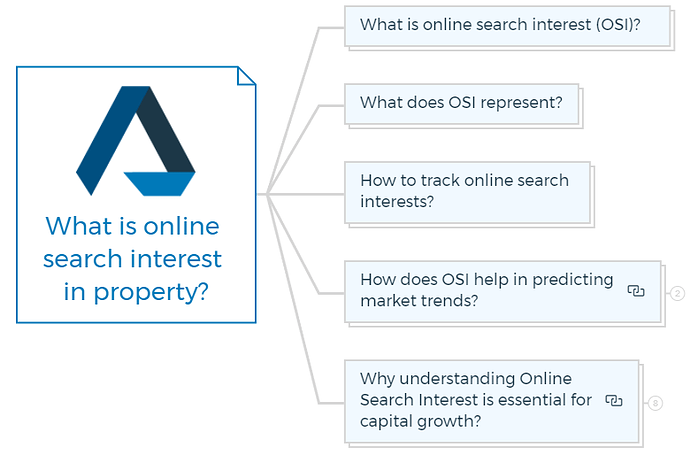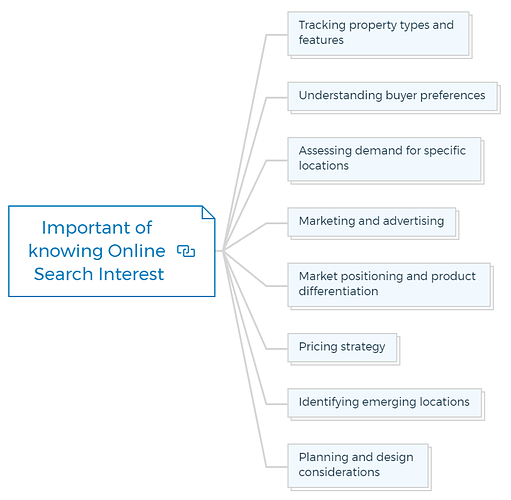What is online search interest in property?
As we all know, every click and tap you make on the internet is being recorded and collected, but what for?
When a property is up for sale, an online ad is posted on credible websites. When a person in need looks forward to his searches over the internet, he narrows down the search criteria. As a result, every recorded click is quantified.
This creates a comparison between the searches performed online by people looking for a property in a specific market versus the properties for sale in the same market. This is what the online search interest metric tells us.
What is online search interest (OSI)?
Online search interest or OSI is a ratio that compares the number of people searching for a property on different online property portals versus the number of properties available for sale.
OSI or Online Search Interest helps us draw a little Demand-to-Supply ratio. It shows the number of people searching for specific properties, representing the demand.
Moreover, it also shows the properties up for sale or to be rented on the market, representing supply.
For example, if there are 50 properties listed for sale in a specific location or suburb in Australia and approximately 500 people are looking for properties in that suburb, then the OSI is 50.
What does OSI represent?
Like every other statistical analysis, OSI also holds important links to its core. For instance, a higher number of OSI signifies a high demand or low supply, whereas the scenario is the opposite for fewer searches made.
For an OSI to exist, there must be properties for sale in the market. If there is even one property on the market and zero number of searches, then it would indicate that the market is in a slump.
Therefore, the higher the number of OSI, the more demand for property compared to the supply ratio for the potential buyers looking for properties online.
You are missing out if you haven’t yet subscribed to our YouTube channel.
How to track online search interests?
Tracking online search interest on different property portals can be a valuable method to determine property demand. Here are some general steps to track online search interest on property portal:
- Identify the relevant property portal.
- Set up an account
- Explore the analytics dashboard
- Search volume and property views
- Filter by location and property types
- Time range analysis
- Compare properties
- Monitor featured and trending listings
- Consider additional insights
- Regularly analyse and adjust
How does OSI help in predicting market trends?
Early indication of market sentiment:
Real estate professionals can gauge buyer and seller mood by analysing online search interest. Search volume changes may suggest market conditions, buyer preferences, or new trends.
Real estate professionals and investors might find new or undervalued locales by monitoring search activity. They can discover regions with rising interest by analysing search patterns.
Identifying emerging locations
Online search interest helps identify popular property types and characteristics. Search patterns may show an increasing interest in eco-friendly homes, open-concept designs, or specific features like pools or home offices.
Property Developers and agents can use this data to suit market demand.
Why understanding Online Search Interest is essential for capital growth?
Understanding online search interest is essential for capital growth in property development due to the following reasons:
Tracking property types and features
Online search interest helps identify popular property kinds and characteristics. Search patterns may show an increasing interest in eco-friendly homes, open-concept designs, or specific features like pools or home offices. Real estate developers and agents can use this data to suit market demand.
Understanding buyer preferences
Real estate agents can learn buyer preferences by analysing online search queries and patterns. They can use buyer preferences to adjust their marketing and property offerings.
Assessing demand for specific locations
Online search interest helps real estate agents determine location demand. Agents can recommend popular neighbourhoods or cities by tracking search volumes.
Marketing and advertising
Developers can boost project visibility by including high-volume keywords and subjects in their marketing materials. Online search-based digital marketing can increase interest, enquiries, and capital growth.
Learn More
Market positioning and product differentiation
Property developers can obtain a competitive edge by measuring online search interest to learn what features and facilities potential buyers want.
This understanding helps developers set their projects apart from competitors and appeal to the target market. Developers can boost property values by adding desired features.
Pricing strategy
Online search interest data might reveal buyer price range and budget expectations. Developers can choose the best pricing approach by analysing search volumes for different price points.
Understanding market price sensitivity helps developers set competitive property prices to attract buyers and maximise capital growth.
Identifying emerging locations
Developers can identify popular and potentially profitable areas by tracking search volumes. Real estate developers can focus on places that will attract purchasers and have strong market dynamics, resulting in long-term capital appreciation.
Planning and design considerations
Online search interest reveals potential purchasers’ desired features, layouts, and design aspects. Developers can meet market demand by including these preferences in planning and design. This strategy attracts buyers and boosts capital growth.
Test Your Knowledge
Understanding Online Search Interest in Property: An Interactive Assignment
Objective:
This assignment is designed to help students apply their understanding of online search interest (OSI) in the real estate market. By engaging in practical exercises, students will learn how to track and analyse OSI to identify market trends, buyer preferences, and real estate capital growth opportunities.
Part 1: Research and Analysis
- To Do: Choose a specific location or suburb within your country of interest for real estate market analysis. Preferably, select an area you find intriguing or potentially valuable for investment purposes.
- Question: What are the main property portals or online platforms used in your chosen location for listing properties? List at least three and provide a brief overview of their features and analytics tools, if available.
- To Do: Using the identified property portals, track the number of properties for sale and the volume of searches for your selected location over the past month. Document your findings.
- Question: Calculate the OSI for your selected location based on the data collected. How does this OSI compare to what you might have expected? Discuss any factors that could influence the OSI in this area.
Part 2: Market Trends and Predictions
- To Do: Analyze the search patterns and preferences indicated by the search volume. Identify any trends in property types (e.g., eco-friendly homes, open-concept designs) or specific features (e.g., pools, home offices) that are gaining popularity in your selected area.
- Research Question: How can the identified trends inform real estate developers and investors about market demand? Provide specific examples based on your analysis.
- To Do: Investigate any emerging locations within or near your selected area by analyzing search interest patterns. Discuss why these locations might be becoming popular and potential reasons for increased buyer interest.
Part 3: Strategy and Application
- Question: Based on your understanding of OSI and the data collected, how can real estate professionals use OSI to improve their marketing and advertising strategies? Give examples of how high-volume keywords and subjects could be integrated into marketing materials.
- To Do: Propose a marketing strategy for a hypothetical new development project in your selected area, incorporating insights gained from OSI analysis. Focus on market positioning, product differentiation, and pricing strategy.
- Research Question: How does OSI influence pricing strategy and market positioning for new development projects? Discuss how developers can use OSI data to set competitive property prices and differentiate their projects from competitors.
- To Do: Reflect on the role of OSI in planning and design considerations for real estate development. Suggest how a developer could integrate popular features, layouts, and design aspects identified through OSI into their upcoming project to attract buyers and boost capital growth.
Submission Guidelines
- Compile your findings, calculations, and analyses into a comprehensive report.
- Include visuals such as charts or graphs to illustrate OSI trends, search volume analysis, and other relevant data.
- You can share your assignment via mail or comments.







